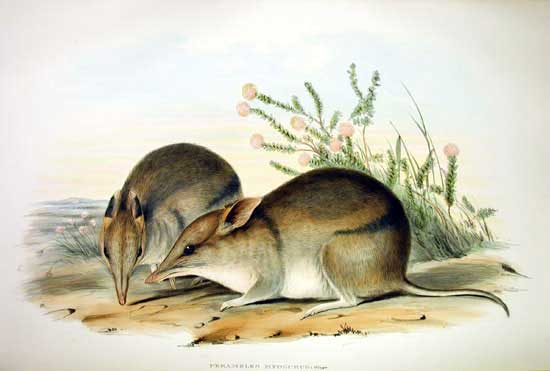Perameles bougainville (*) Cladus: Eukaryota Name Perameles bougainville Quoy & Gaimard, 1824 Type locality: Australia, Western Australia, Shark Bay, Peron Peninsula Vernacular names References * Perameles bougainville on Mammal Species of the World. ------------- The Western Barred Bandicoot (Perameles bougainville), also known as the Marl, is a small species of bandicoot found in Australia. It was once widespread across southern Australia from Western Australia to central New South Wales, but it is now found on Bernier, Dorre and Faure islands in Shark Bay, Western Australia,[3][4] and in captive populations on the mainland including at Barna Mia in Dryandra Woodland.[5] The Western Barred Bandicoot is much smaller than its relative the Eastern Barred Bandicoot (Perameles gunnii), and is darker in its colouring, which is a grizzled brown. It measures about 1.5 feet in length.[6] It has two "bars" across its rump and has a short, tapered tail.[6] It is a solitary and crepuscular hunter, eating insects, spiders, and worms and occasionally tubers and roots.[6] When the bandicoot feels threatened, it typically leaps into the air and then burrows to safety.[6] This species is currently being re-introduced to nearby mainland areas of Western Australia, where predators such as the Red Fox are the subject of control programs.[3] It has also been successfully reintroduced into the Arid Recovery Reserve at Roxby Downs in South Australia. References 1. ^ Groves, C. (2005). Wilson, D. E., & Reeder, D. M. ed. Mammal Species of the World (3rd ed.). Baltimore: Johns Hopkins University Press. pp. 39. ISBN 0-801-88221-4. http://www.bucknell.edu/msw3. Source: Wikispecies, Wikipedia: All text is available under the terms of the GNU Free Documentation License |
|


